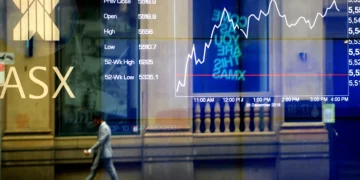Introduction: An Examination of Rising National Debts Within the Eurozone and the EU’s Response
The Eurozone, comprising 19 of the European Union’s 27 member states, is facing a mounting debt crisis that threatens to destabilize the entire region. After years of economic instability, the COVID-19 pandemic, and the ensuing supply chain disruptions and energy crises, national debts in several Eurozone countries have reached unsustainable levels. Nations like Italy, Spain, France, and Greece have all seen their debt-to-GDP ratios rise to alarming heights. The consequences of this burgeoning debt crisis are not limited to government balance sheets but extend to the broader European economy, affecting everything from growth prospects to the stability of the euro.
At the core of this problem is the Eurozone’s fiscal architecture. While the European Central Bank (ECB) has taken extensive measures to keep borrowing costs low through monetary policy tools, such as quantitative easing and interest rate cuts, these measures have done little to resolve the underlying fiscal imbalances in many Eurozone countries. As the EU navigates this fiscal dilemma, questions are emerging about the effectiveness of its current approach to managing debt and whether it needs to adopt more flexible policies to avoid a full-blown debt crisis.
This article will examine the debt dynamics within the Eurozone, explore the EU’s fiscal rules, analyze market reactions to the growing debt burden, and discuss the outlook for the region’s economic future.
Debt Dynamics: How Countries Like Italy, Spain, and France Are Grappling with Unsustainable Debt Levels
Several key Eurozone nations are facing escalating debt levels that have raised serious concerns about their long-term fiscal sustainability. Italy, Spain, and France are among the countries most affected by rising debt burdens.
- Italy: Italy has one of the highest public debt-to-GDP ratios in the world, approaching 160%. The country’s debt has been rising steadily for years, fueled by sluggish growth, an aging population, and political instability. The combination of these factors has made it difficult for Italy to reduce its debt load, even in times of economic expansion. Moreover, Italy’s high debt levels mean it has limited fiscal flexibility, as it must devote a significant portion of its budget to servicing the debt.
- Spain: Spain’s debt-to-GDP ratio has surged in recent years, reaching approximately 120%. Like Italy, Spain faces structural challenges such as a relatively high unemployment rate, weak productivity growth, and a reliance on the tourism industry. While the Spanish government has implemented fiscal reforms, the country’s growing debt burden and the lingering effects of the global financial crisis and pandemic have hampered its recovery.
- France: France’s debt-to-GDP ratio stands at over 115%, driven by both increased government spending (particularly in social programs) and sluggish economic growth. While France has not faced the same level of market scrutiny as Italy or Spain, its debt trajectory remains a concern. France also has relatively high levels of unemployment, particularly among younger workers, and is facing political challenges as labor unions and social movements push back against austerity measures.
The growing debt loads in these countries have implications not just for their domestic economies but for the entire Eurozone. Given the interconnected nature of the European economy, a debt crisis in one country can quickly spill over into others, causing widespread financial instability.

EU Fiscal Rules: The Debate Over Fiscal Rules and Whether the EU Should Adopt a More Lenient Approach to Help Member States Recover
The EU’s fiscal framework has long been based on a set of rules designed to ensure that member states maintain sound public finances and avoid excessive debt accumulation. Under the Stability and Growth Pact (SGP), countries are required to keep their budget deficits below 3% of GDP and their debt-to-GDP ratios below 60%. However, these rules have often been criticized as too rigid, particularly in times of economic downturns, when countries may need to increase spending to stimulate growth.
As debt levels across the Eurozone continue to climb, the debate over these fiscal rules has intensified. Some policymakers argue that the rules are too restrictive and prevent countries from using fiscal policy to support economic growth and job creation. Others, particularly in Germany and the Netherlands, maintain that stricter fiscal discipline is necessary to avoid the risk of sovereign debt defaults and to protect the euro from speculative attacks.
In response to the pandemic, the EU temporarily suspended its fiscal rules to allow member states to boost spending without facing penalties. This temporary suspension of the Stability and Growth Pact has led to a wider discussion about whether these rules should be permanently reformed to provide more flexibility for countries facing economic challenges. Countries like Italy and Spain, which have high debt-to-GDP ratios, argue that a more lenient approach to fiscal policy could help them invest in growth-driving areas such as infrastructure, education, and technology.
Despite this debate, the EU has yet to reach a consensus on the long-term direction of its fiscal rules. While some advocate for an increase in the debt limits or a greater focus on sustainability and investment, others believe that a stricter fiscal framework is necessary to maintain economic stability in the long run.
Market Reactions: How Markets Are Reacting to the Growing Debt Burden in Europe, Especially in Bond Markets and Credit Ratings
Markets have responded cautiously to the growing debt burden in the Eurozone, particularly in countries with high debt-to-GDP ratios. Sovereign bond yields in countries like Italy and Spain are highly sensitive to changes in market sentiment, as investors demand higher returns to compensate for perceived risks. While the European Central Bank (ECB) has kept borrowing costs low through its monetary stimulus programs, this has not eliminated market concerns about the long-term sustainability of Eurozone debt.
- Bond Markets: In recent years, yields on Italian government bonds have spiked at times of market uncertainty, reflecting investor concerns over Italy’s debt load. Similarly, the bond yields of other highly-indebted countries like Spain have also risen during periods of heightened risk. While the ECB has intervened to purchase government bonds and keep interest rates low, there is growing concern that such measures may not be sustainable in the long run.
- Credit Ratings: Credit rating agencies have also raised red flags over the rising debt levels in some Eurozone countries. For instance, Italy’s credit rating remains at BBB, which is a relatively low investment-grade rating. A downgrade in credit ratings for countries with high debt-to-GDP ratios could lead to higher borrowing costs and further economic strain.
- Investor Sentiment: Investor sentiment in the Eurozone has been volatile due to concerns over debt sustainability. As the economic recovery from the pandemic remains uneven, many investors are hesitant to invest heavily in government bonds of highly indebted Eurozone countries, as they fear a potential debt crisis in the future.
The market’s reaction to rising debt levels in the Eurozone underscores the challenges that the EU faces in addressing its fiscal imbalances. While the ECB’s policies have helped mitigate some immediate risks, there are growing concerns about the long-term sustainability of the Eurozone’s economic model.
Outlook: Will the EU Implement Debt-Reduction Strategies That Will Stabilize the Economy, or Is a Debt Crisis Inevitable?
As the debt crisis continues to unfold, the EU is under increasing pressure to implement debt-reduction strategies that will stabilize the economy and restore confidence in the Eurozone’s financial system. While it is difficult to predict whether a full-blown debt crisis is imminent, several key factors will influence the region’s ability to navigate this crisis:
- Fiscal Reforms: The EU will need to introduce fiscal reforms that allow member states to reduce their debt burdens without stifling economic growth. This could involve a more flexible approach to fiscal policy, greater emphasis on sustainable investment, and coordinated efforts to tackle inefficiencies in government spending.
- Monetary Policy: The ECB will continue to play a crucial role in supporting Eurozone economies through its monetary policies. However, if inflationary pressures rise or if bond yields spike too high, the ECB may face challenges in keeping borrowing costs low for highly indebted countries.
- Structural Reforms: Structural reforms aimed at increasing productivity, reducing unemployment, and boosting economic growth will be crucial in addressing the root causes of high debt levels. These reforms may include labor market changes, investment in innovation, and tax reforms to ensure more equitable revenue generation.
- Political Will: The willingness of EU member states to adopt common solutions will be essential in avoiding a debt crisis. Given the political differences between northern and southern European countries, reaching a consensus on fiscal reforms will be challenging.
While the EU has taken steps to mitigate the risk of a debt crisis, its ability to implement effective debt-reduction strategies will determine whether it can avoid economic instability in the long term. If the EU fails to address the underlying causes of rising debt, a crisis could become inevitable.
Conclusion
The Eurozone’s growing debt crisis presents significant challenges for both policymakers and investors. While the EU has made efforts to address the issue through monetary policy and temporary suspensions of fiscal rules, the underlying fiscal imbalances in countries like Italy, Spain, and France remain a major concern. The debate over fiscal flexibility and debt reduction strategies will continue to shape the future of the Eurozone’s economy.
Ultimately, the EU must find a balance between maintaining fiscal discipline and allowing member states the flexibility to invest in sustainable growth. Without significant fiscal reforms, the region risks deeper economic instability, but with the right policies, it could chart a path toward long-term debt sustainability.





































